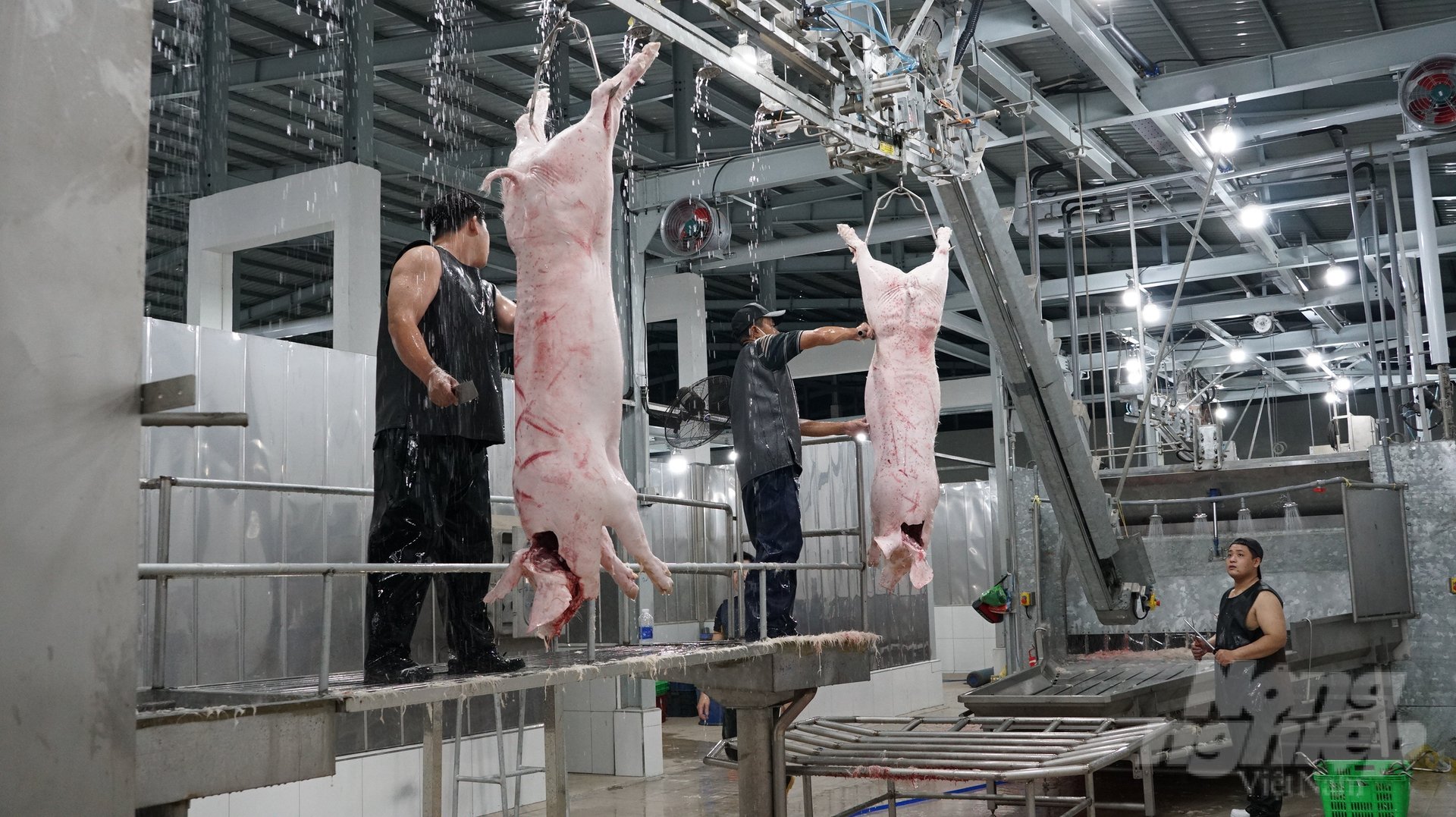November 22, 2025 | 19:43 GMT +7
November 22, 2025 | 19:43 GMT +7
Hotline: 0913.378.918
November 22, 2025 | 19:43 GMT +7
Hotline: 0913.378.918

Mr. Dinh Minh Hiep, Director of Ho Chi Minh City Department of Agriculture and Rural Development, answering inquiries at the press conference. Photo: Nguyen Thuy.
A press conference on socio-economic issues and disease prevention city was in Ho Chi Minh city held on June 8. Mr. Dinh Minh Hiep, Director of Ho Chi Minh city's Department of Agriculture and Rural Development, commented on the control of livestock and poultry slaughtering in Ho Chi Minh city at the press conference. Accordingly, Ho Chi Minh City People's Committee issued a Decision to cease the operation of all manual slaughterhouses by the end of March 31. Subsequently, all slaughtering operations were moved to industrial slaughterhouses starting from April 1.
As a result, eight manual slaughterhouses in the city have ceased operation since April 4, including Binh Tan slaughterhouse in Binh Tan district; Phuoc Kien slaughterhouse in Nha Be district; Tan Phu Trung, Hoa Phu, Phu Hoa Dong, Tan Thanh Dong, Xuyen A slaughterhouses in Cu Chi district and a manual slaughtehouse belonging to Hoc Mon Food Processing Joint Stock Company in Hoc Mon district.
According to Decision No. 231/QD-UBND, Trung Tuyen slaughterhouse in Can Gio district will remain in operation with a daily capacity of 20 to 30 pigs to supply consumers in Can Gio district.
According to Mr. Hiep, Ho Chi Minh City currrently has five industrial slaughterhouses in Cu Chi, Hoc Mon and Binh Thanh districts and one in Can Gio district. The average daily slaughter capacity from April 1 to June 8 falls between 5,200 and 6,000 heads, which can supply 60% of the market's demand for pork.
Loc An Slaughterhouse belonging to Loc An Food Company Limited is one of three industrial slaughterhouses in Cu Chi district. It has an average slaughter capacity of 900 to 1,000 pigs per day, which is an increase of at least 20% compared to its slaughter capacity before April 1. The slaughterhouse has a designed capacity of 2,000 pigs per day.
A slaughterhouse belonging to Saigon Agriculture Incorporation Company (Sagri) currently has an average slaughter capacity of 50 to 80 pigs per day; which is an increase of 45% compared to its slaughter capacity before April 1. This slaughterhouse also has a designed capacity of 2,000 pigs per day.
An Ha cattle slaughtering and food processing plant belonging to An Ha Service Co., Ltd currently has an average slaughter capacity of 1,900 to 2,300 pigs per day; which is an increase of 8% compared to its slaughter capacity before April 1. This processing plant has a designed capacity 3,200 heads per day.
Xuan Thoi Thuong slaughterhouse belonging to Hoc Mon Food Processing Joint Stock Company in Hoc Mon district currently has an average slaughter capacity of 1,900 to 2,100 pigs per day; which is a decrease of 6% compared its capacity before April 1. The slaughterhouse has a designed capacity of 2,000 pigs per day per plant.
A slaughterhouse in Binh Thanh district belonging to the Vissan Joint Stock Company currently has an average slaughter capacity of 400 to 500 pigs per day. This slaughter house has a designed capacity of 1,000 pigs per day.

Ho Chi Minh City Department of Agriculture and Rural Development inspecting An Ha cattle slaughtering and food processing plant. Photo: Nguyen Thuy.
According to Mr. Dinh Minh Hiem, there was negligible changes in the overall supply of pork to the city market compared to before April 4, with an average output of approximately 9,500 to 10,000 pigs per day.
The daily source of slaughtered pigs in the city decreased by nearly 700 to 1,200 heads, which is a decrease of 10 to 15%. This decline was caused by cattle owners moving to Long An, Binh Duong for slaughter, then delivering them back to Ho Chi Minh City. On the other hand, some cattle owners switched to selling meat instead of buying live pigs for slaughter.
Moreover, the amount of pork brought from the provinces to the city for consumption during this period increased by roughly 500 to 1,300 pigs, which is an increase of 15 to 20%.

An Ha cattle slaughtering and food processing factory was designed with a daily slaughter capacity of 3,200 pigs. Photo: Nguyen Thuy.
The Ministry of Agriculture and Rural Development held a "Conference on control of animal slaughter, and implementing Directive No. 02/CT-TTg by the Prime Minister" on June 3 in Hanoi city. According to Ms. Nguyen Thu Thuy, Deputy Director of the Department of Animal Health, local governments are effectively organizing concentrated and industrial-scale animal slaughter activities, controlling food safety, and traceability when necessary. Namely, the governments of Ho Chi Minh City, Ha Tinh, Long An, Thua Thien Hue, Ba Ria - Vung Tau provinces were praised for their success.
"Ho Chi Minh City has worked on converting from manual slaughterhouses to industrial slaughterhouses for the past ten years. This is the only city in Vietnam that has completed its conversion to industrial slaughterhouses" Mr. Dinh Minh Hiep reported.
The control of slaughter at industrial slaughterhouses in Ho Chi Minh City have reportedly ensured the requirements for animal health and hygiene.
"The volume of slaughter at industrial slaughterhouses have been relatively stable. However, these industrial slaughterhouses have not reached their designed capacity. If we connect with more partners for industrial cattle slaughter, these slaughterhouses will increase their capacity and maintain the supply of pork to meet the needs of consumers", added Mr. Hiep.
The Sub-Department of Livestock Production and Animal Health of Ho Chi Minh City recently strengthened the inspection of manual slaughter in the city, with a focus on District 12, Go Vap, Binh Chanh, but no such cases were found.
Translated by Nguyen Hai Long

(VAN) Results from the Sustainable Durian Model Project in Dak Lak have confirmed the critical role of Yara Viet Nam in transferring advanced nutritional solutions to farmers.

(VAN) In Tuyen Quang province, livestock farmers have introduced effective models and innovative practices that significantly strengthen African Swine Fever prevention and control efforts.

(VAN) This is the study conducted by IRRI and Can Tho University on the rice straw value chain in Mekong Delta showing an economic potential of more than 6.6 trillion VND/year.

(VAN) By participating in cooperative economics, many farmers in Tay Ninh have overcome hardship, mastered clean dragon fruit cultivation techniques.

(VAN) The crossbreeding program in the former Binh Dinh province (now part of Gia Lai) has shown signs of decline, and urgent measures are needed to revive it and sustain past achievements.

(VAN) The agricultural sector agreed on a roadmap to pilot the MRV protocol and expand low-emission rice production from the 2025-2026 winter-spring crop.

(VAN) Agricultural extension officers in Quang Ninh do more than transmit knowledge; they have become a steadfast support system for farmers on the path to sustainable agricultural development.